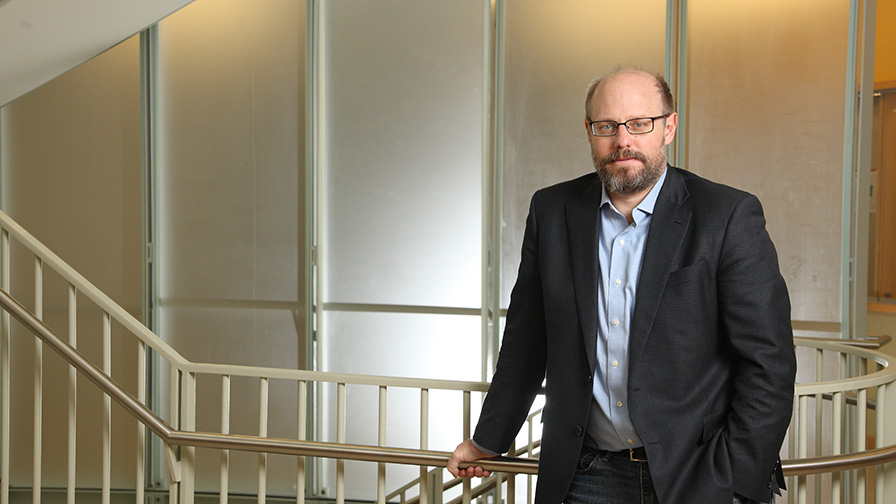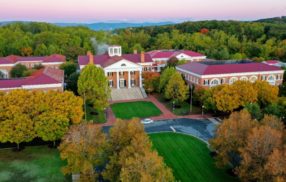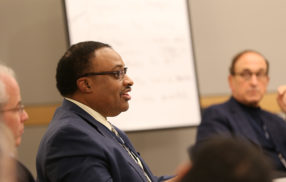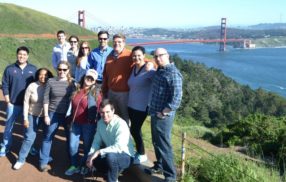
Cracking the Code: Professor Casey Lichtendahl Helps UVA Darden Students Unlock Power of Data Science
By Laura Longhine
Today’s businesses can collect an ever-increasing amount of data. But what data do you collect, and how do you use it?
The field of data science has emerged to help address those questions. For business leaders, understanding data science is increasingly important, so University of Virginia Darden School of Business Professor Casey Lichtendahl decided to build a course around it.
“Data Science in Business,” introduced two years ago, focuses on how computer science, statistics and business knowledge intersect in the world. The popular Second Year elective expanded last fall and was co-taught in the 2015–16 academic year by Lichtendahl and Eric Tassone, a data scientist at Google who holds a Ph.D. in biostatistics.
According to Lichtendahl, the course developed from seeing how important data science has become to companies in Silicon Valley.
“They are on the leading edge. They’re pioneering a lot of the applications of these concepts to business,” Lichtendahl said about companies like Google, Facebook and the next generation of emerging tech companies. “It’s exciting, and they’re making huge profits on this. And they’re hiring lots of our students.”
As a class, “Data Science in Business” is something of a hybrid. “We’re actually trying to teach MBA students how to code, but we’re doing it in the context of trying to solve and talk about a real business problem,” Lichtendahl said. “It’s this marriage of case method and coding.”
Lichtendahl presents starter code with each case, and students must gradually complete more of the code themselves as the class progresses. That unique approach helped him win Outstanding Case Teacher 2015 at the Case Centre Awards, which recognize excellence in case writing and teaching in business education. One judge commented that mixing traditional cases with coding was “something that is unusual and yet poised to become more important as schools learn to teach students how to use big data.”
Tassone was an instructor for the “Statistics in the Courtroom” course at Duke before moving to Google in 2007 and missed being in the classroom. The 1998 UVA School of Law graduate was particularly excited about the prospect of teaching students who were challenging themselves to go outside the typical knowledge base of their field.
“This elective is an opportunity for the students to really challenge themselves with cutting-edge, real-world methods and technologies,” Tassone said.
Lichtendahl said Tassone’s expertise as a leading practitioner in the world of time-series forecasting makes the course stronger and also gives students exposure to an elite company like Google.
“Now I’m learning from Eric how this stuff actually gets put into practice and what is more and less meaningful,” Lichtendahl said. “For him to be here and be a voice for Google in terms of recruiting our students, I think that’s consistent with Google’s mission. And it’s certainly consistent with our mission here at Darden, to have practitioners that can really help these MBA students become leaders in the world.”
The course includes five modules:
- Data visualization
- Time series
- Advanced regression techniques
- Machine learning
- Text analysis
With Tassone on board, the two expanded some course content and added new cases, including one using data from Google Trends, which allows users to enter any search term and see its search volume over time. Written with Professor Yael Grushka-Cockayne and Xiaojia Guo, a graduate student at University College London, the case has served as a springboard for an ongoing research project aimed at better predicting the lifecycles of social media companies.
“Even if you look at a company like Facebook, its search volume on Google of course exploded but more recently it’s starting to come down,” Lichtendahl explained. “If you go back and look at the hundred or so social media companies that started up over the last 15 years, they follow these similar rise and fall patterns.”
“There really aren’t good statistical models that can put together and capture the pattern we see in these lifecycles,” he added. “So we’re trying to develop a better model.” Though still in development, their model has been proving more accurate than some other competing models, Lichtendahl said.
In the course, the case study on Google Trends is meant to teach students about the data science process — from forming a good question and making hypotheses to actually collecting the data. They use a technique called Web scraping to collect the data from Google Trends, and work with it in R — a free, open-source statistical computing language that students use throughout the course.
“I realized that students may want to learn R; that people in practice are actually using it like they use Excel — even on Wall Street, there’s a growing contingency of folks who are treating R like it’s Excel in the ’80s or ’90s. It’s their core analytical workhorse,” he said.
For their final project, students work in groups to build their own case — they propose a problem, collect a data set, build a model and make predictions, and then report back on how well their model did.
“We look at who asked a really hard question, who found a really great data set to answer that question, and how did answering that have an impact on business,” Lichtendahl said. “Did it help somebody think about a new business, or a better way to do something that already exists?”
While some students are seeking to master technical skills, for others the course’s value is in exposure to the way data scientists work. Bridging the gap between such scientists and people with business expertise is a challenge in current business practices, Lichtendahl said. He and Tassone believe it is one MBAs can meet if they have enough exposure to the workings of data science.
“If this course can help our students have the ability to understand the whole process, I think they’re going to have a real edge in the workplace,” Tassone said. “The data itself is growing, the data scientist role is growing, and data analyst jobs are growing. If they can develop the ability to thoughtfully critique and push back on this work, it’s going to be a better environment for everybody.”
The University of Virginia Darden School of Business prepares responsible global leaders through unparalleled transformational learning experiences. Darden’s graduate degree programs (MBA, MSBA and Ph.D.) and Executive Education & Lifelong Learning programs offered by the Darden School Foundation set the stage for a lifetime of career advancement and impact. Darden’s top-ranked faculty, renowned for teaching excellence, inspires and shapes modern business leadership worldwide through research, thought leadership and business publishing. Darden has Grounds in Charlottesville, Virginia, and the Washington, D.C., area and a global community that includes 18,000 alumni in 90 countries. Darden was established in 1955 at the University of Virginia, a top public university founded by Thomas Jefferson in 1819 in Charlottesville, Virginia.
Press Contact
Molly Mitchell
Associate Director of Content Marketing and Social Media
Darden School of Business
University of Virginia
MitchellM@darden.virginia.edu






